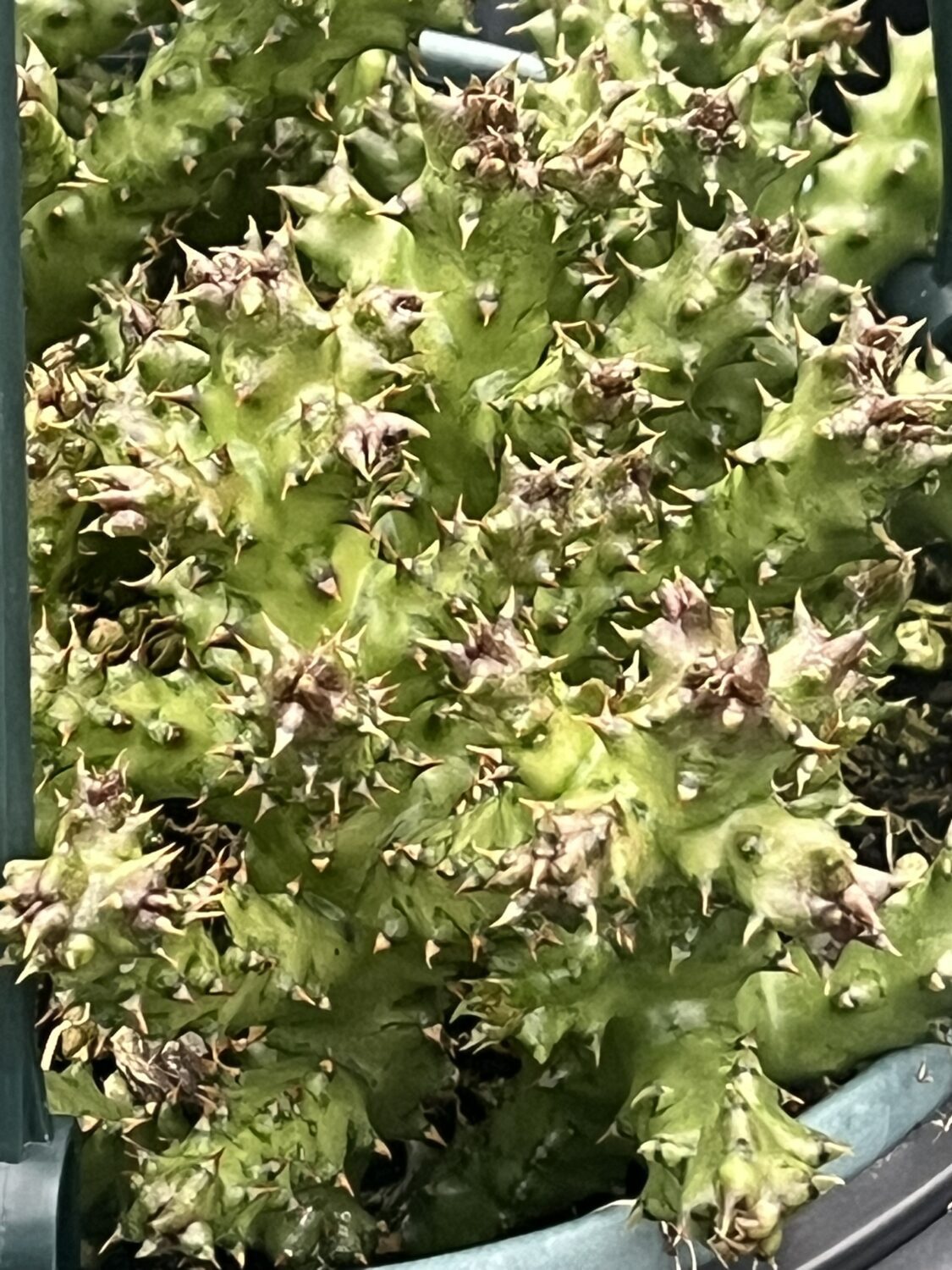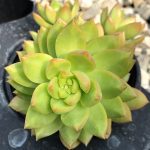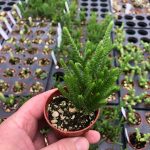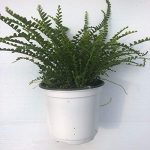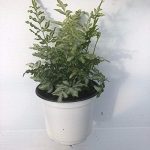Edithcolea grandis ‘Persian Carpet Flower’
Price range: $9.99 through $34.99
Hardiness Zone 9+
Discount per quantity
| Quantity | 3 - 8 | 9 - 14 | 15+ |
|---|---|---|---|
| Price | Price range: $9.69 through $33.94 | Price range: $9.39 through $32.89 | Price range: $8.99 through $31.49 |
| % Discount | 3% | 6% | 10% |
Description
Edithcolea grandis ‘Persian Carpet Flower’: The Ultimate Guide to Growth and Care
Few plants stop people in their tracks like the Edithcolea grandis. Known affectionately as the Persian Carpet Flower, this succulent is a showpiece of bold colors and intricate detail. Its blooms look as though they’ve been woven rather than grown, with red, maroon, and yellow patterns that resemble a luxurious rug.
Native to the dry landscapes of East Africa and the Arabian Peninsula, this rare succulent thrives in tough conditions yet rewards growers with flowers that feel almost otherworldly. It’s an exceptional plant for collectors, but also surprisingly manageable for beginners who want something truly unique.
In this guide, we’ll explore everything you need to know about Edithcolea grandis—from its fascinating appearance and natural habitat to detailed tips on care, propagation, and solving common problems.
The Captivating Beauty of the Persian Carpet Flower
Edithcolea grandis is unlike most succulents you’ll encounter. It’s not the type that quietly blends into a windowsill display; it demands attention.
A Star-Shaped Masterpiece
The plant’s flowers are its claim to fame. Measuring up to five inches (12 centimeters) across, they open into a perfect five-pointed star. Each petal is richly patterned with burgundy spots and yellow veins, mimicking the intricate designs of handwoven carpets. A ringed, raised center adds to the illusion of embroidery, making the bloom appear almost textile-like.
Succulent Stems with Hidden Charm
While the flowers steal the show, the stems themselves are equally interesting. Edithcolea grandis is a stem succulent, meaning it stores water in its thick, fleshy shoots rather than leaves. These stems are greenish-gray, sometimes flushed with purple, and covered in tiny, soft spines. Over time, the plant forms a sprawling mat, with stems trailing over pots or creeping across sandy ground in habitat.
Why Grow Edithcolea grandis?
Adding this succulent to your collection offers more than just aesthetic appeal.
-
Exotic and Rare: Few people grow this plant, making it a prized addition for collectors.
-
Drought Tolerant: It thrives on neglect, perfect for water-wise gardens and xeriscaping.
-
Conversation Starter: Its flowers are so unusual that they inevitably spark curiosity.
-
Compact Growth: Sprawling yet low to the ground, it suits both containers and greenhouse benches.
In short, it’s a plant that combines resilience with beauty—something that’s rare in the plant world.
Understanding Its Natural Habitat
Knowing where Edithcolea grandis comes from helps explain how to care for it.
-
Native Range: Found in arid regions of Somalia, Ethiopia, Tanzania, Kenya, and Yemen.
-
Climate: Hot days, cool nights, minimal rainfall.
-
Soil: Rocky, sandy terrain with exceptional drainage.
-
Light: Bright sun filtered by rocks or sparse shrubs.
In other words, this is a plant that expects intense light, fast-draining soil, and very little water. Replicating these conditions at home ensures long-term success.
How to Grow Edithcolea grandis
Caring for this succulent is straightforward if you understand its basic needs. Here’s a detailed look at each requirement.
1. Light Requirements
Bright light is essential for healthy growth and flowering. However, harsh sun can scorch the stems, so balance is key.
Indoors
-
Place near a south-facing or east-facing window.
-
If light is weak, supplement with a grow light.
Outdoors
-
Provide bright but filtered light, such as beneath a shade cloth or on a porch with indirect exposure.
-
In extremely hot regions, afternoon shade helps prevent sunburn.
2. Soil Mix
Poor drainage is the number-one killer of this plant. A gritty, fast-draining mix is non-negotiable.
Ideal Blend:
-
50% coarse sand or pumice
-
30% potting soil (lightweight, not peat-heavy)
-
20% perlite or crushed gravel
This mimics its native soil and prevents excess moisture from lingering around the roots.
3. Watering Schedule
Edithcolea grandis is a true drought survivor. Overwatering leads to root rot, so adopt a “less is more” approach.
-
Spring–Summer (active growth): Water every 2–3 weeks. Allow the soil to dry completely between waterings.
-
Fall–Winter (dormancy): Water sparingly—once a month or less.
Tip: Always water deeply, then drain thoroughly. Never let the pot sit in water.
4. Temperature and Humidity
This plant loves warmth and struggles with cold.
-
Optimal range: 70–90°F (21–32°C)
-
Minimum: Do not expose below 50°F (10°C).
-
Humidity: Prefers dry air. Avoid high humidity zones like bathrooms or poorly ventilated greenhouses.
5. Fertilizing
During active growth, feed lightly to encourage flowering and healthy stems.
-
Use a diluted cactus or succulent fertilizer (half-strength).
-
Apply every 4–6 weeks from spring through late summer.
-
Stop feeding in fall and winter.
Propagating Edithcolea grandis
Propagation is one of the most rewarding aspects of growing this plant. It’s typically done through stem cuttings.
Step-by-Step Method
-
Select a Healthy Stem
Choose a firm, disease-free segment. Cut with a clean, sharp knife. -
Callous the Cutting
Let the cutting sit in a shaded, dry spot for 2–3 days. This seals the wound and prevents rot. -
Plant in Dry Soil
Place the cutting upright in a gritty succulent mix. Do not water immediately. -
Wait to Water
After about a week, lightly mist the soil. Gradually increase watering as roots form. -
Provide Bright Light
Keep in bright, indirect light to encourage strong growth.
Within a few weeks, the cutting should establish roots and begin producing new stems.
Managing Pests and Problems
Even hardy plants encounter challenges. Here’s how to troubleshoot common issues with Edithcolea grandis.
1. Root Rot
Cause: Overwatering or poor drainage
Symptoms: Mushy stems, foul odor, yellowing
Solution: Remove damaged sections, repot in fresh dry mix, and water less often.
2. Mealybugs and Spider Mites
Cause: Dry, dusty conditions and weak airflow
Symptoms: White cottony patches (mealybugs) or fine webbing (mites)
Solution: Wipe with alcohol-dipped cotton swabs. Treat infestations with neem oil or insecticidal soap.
3. Sunburn
Cause: Sudden exposure to direct sun
Symptoms: White or brown scorched patches on stems
Solution: Move to filtered light and acclimate gradually to stronger sun.
4. Yellowing Stems
Cause: Overwatering or nutrient deficiency
Solution: Reduce watering frequency and feed lightly during growth season.
Seasonal Care Tips
Edithcolea grandis changes its growth pattern with the seasons. Adjust care accordingly.
-
Spring: Resume watering and feeding as temperatures warm. Encourage new growth.
-
Summer: Peak flowering period—maximize light and warmth.
-
Fall: Gradually reduce watering; plant begins slowing down.
-
Winter: Minimal watering; keep dry and warm to avoid cold stress.
Display and Design Ideas
This succulent’s unusual flowers make it a stunning focal point. Here are creative ways to showcase it:
-
Solo in Terracotta: A single plant in a clay pot highlights its intricate blooms and allows excellent airflow.
-
Succulent Arrangements: Pair with low-growing Euphorbias, Aloes, or Haworthias for contrasting textures.
-
Rock Gardens: Perfect for xeriscaped outdoor beds in warm climates.
-
Collector’s Shelf: Display alongside other rare stapeliads for an impressive botanical collection.
Tips for Long-Term Success
-
Rotate the pot every few weeks for even light exposure.
-
Inspect regularly for pests or early signs of rot.
-
Repot every 2–3 years to refresh soil and manage root health.
-
Avoid crowding—good airflow prevents fungal issues.
-
Patience pays off—blooms often appear on mature stems after several months of steady care.
The Joy of Growing Something Rare
Caring for Edithcolea grandis is about more than just keeping a plant alive. It’s about connecting to a part of nature few ever experience. The Persian Carpet Flower is living art—vivid, detailed, and completely unique.
Whether you’re an experienced collector or just dipping your toes into succulent care, this plant rewards attention with unmatched beauty. Give it sun, warmth, and restraint with water, and it will surprise you year after year with blooms that seem almost too perfect to be real.
A Living Tapestry for Your Collection
In the world of succulents, many species are beautiful, but only a handful are truly unforgettable. Edithcolea grandis is one of them. Its Persian carpet-like flowers and sprawling form turn any collection into something extraordinary.
By following the steps in this guide—balancing light, soil, and water—you can create the conditions this plant craves. And once it blooms, you’ll understand why growers around the world cherish it.
Bring home a piece of desert artistry. With the Persian Carpet Flower, your garden—or windowsill—will never be the same.
Additional information
| Weight | N/A |
|---|---|
| Options | 2 in. (3 fl.oz.) Pot, 4 in. (16.9 fl. oz.) Pot, 6 in. Hanging Basket (1 qt) |

